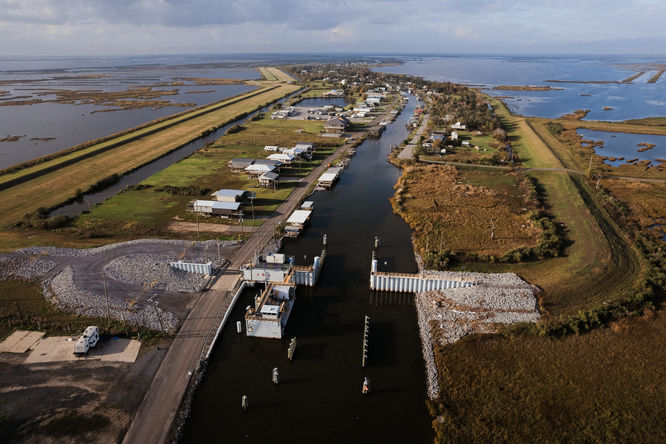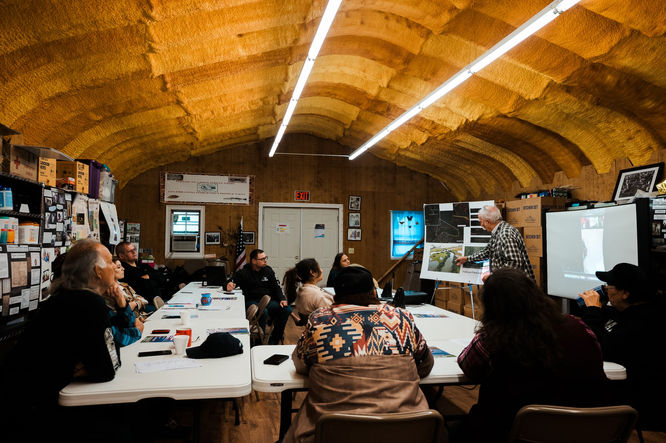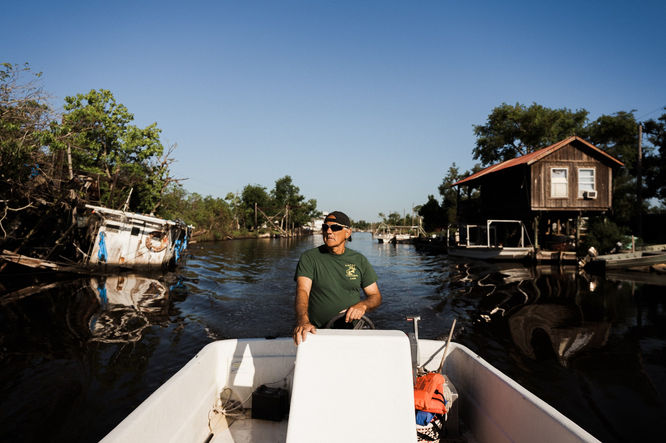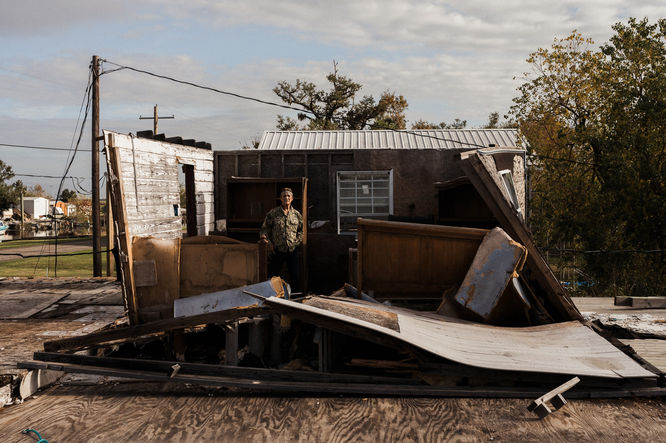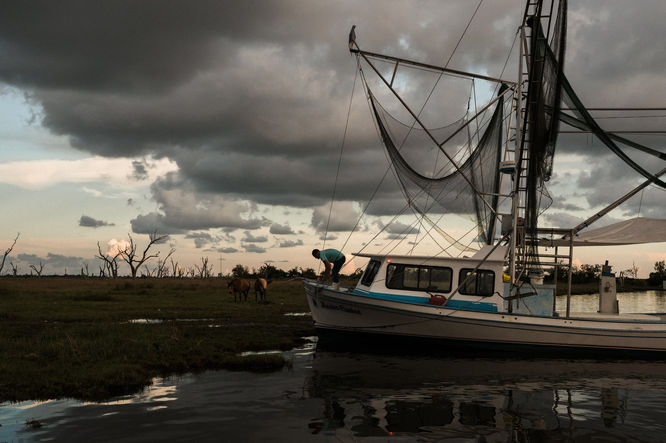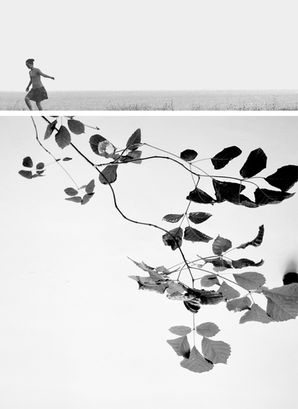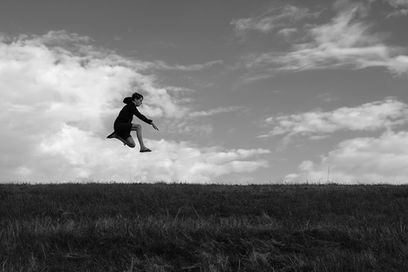
POINTE-AU-CHIEN IS NOT DEAD
Survival of an Indian tribe in South Louisiana
June 1, 2025
INTERVIEW
PHOTOGRAPHY Wayan Barre
INTERVIEW Karen Ghostlaw Pomarico
Photographer Wayan Barre returns to The Pictorial List with another powerful body of work that deepens his commitment to telling the stories of marginalized communities and environments under threat. Based in New Orleans, Wayan is drawn to places where cultures collide, where history and identity are at risk, and where resilience is not a choice — but a legacy. With a practice resonating with compassion through visual storytelling, his photography brings light to voices too often left in the shadows. Wayan’s visual narratives are authentic and captivating, defining the complexities of the communities they portray.
Southern Louisiana, USA. The region and its population are at the forefront of environmental disasters.
The Pointe-au-Chien Indian Tribe is a French-speaking Native American community of 850 members, living down the bayou. For generations, they have faced existential challenges, from protecting their homes against hurricanes, storms, flooding, and land loss to defending their legacy and culture. The annual hurricane season has started, and they are prepared for it.
With the help of scientists, researchers, landscapers, geologists, lawyers, activists, and volunteers, the tribe is looking for ways to fix the past and prepare for the future.
This documentary tells the story of the unprecedented crises and the constant efforts to protect homes as well as traditions.
What this community is experiencing today could give us keys to tomorrow's challenges.
Wayan’s photographs are not just records of loss — they are windows into survival, dignity, and the will to remain. By documenting the lives and lands of those on the front lines of climate change, his work invites us into a larger conversation about displacement, preservation, and the fight for cultural continuity in the face of erasure.
In this follow-up interview, we explore Wayan’s evolving perspective as a photographer, the layered stories behind his photographs, and the meaningful relationships he has formed with the people who inhabit these fragile yet fiercely defended spaces. His work stands as a bridge — between past and future, between community and audience, and between image and action.

“Reading about climate change is one thing; witnessing it unfold around you is something else entirely. When roads flood year after year, when families are forced to leave, when land you once stood on becomes open water — it becomes impossible to ignore. Living in New Orleans has shown me that climate change is not only a scientific or environmental issue — it is also profoundly social. It reveals deep inequalities: who gets protected, who is forgotten, who has the means to recover. Through my photography, I try to make these realities visible — not just the data, but the human cost.”
IN CONVERSATION WITH WAYAN BARRE
THE PICTORIAL LIST: Your work often focuses on communities facing the pressures of both cultural marginalization and environmental change. What drew you back to the Louisiana coast for this chapter in your storytelling?
WAYAN BARRE: I live in New Orleans, so the environmental crises along the coast are not abstract — they’re close, immediate, and visible. I was drawn back because this is one of the most fragile regions in the U.S., and yet so many of the people living here are often overlooked. My work with the Pointe-au-Chien Indian Tribe was being done as I was also documenting Cancer Alley — two intertwined stories showing different faces of vulnerability and resistance in Louisiana. The Pointe-au-Chien Indian Tribe, in particular, represents a powerful intersection of cultural resilience and climate vulnerability. Their story is both deeply local and globally relevant.
TPL: The land loss at Isle de Jean Charles is staggering — from 22,000 acres to just 320. How did you approach documenting this scale of environmental devastation while honoring the people who still call it home?
WAYAN: What happened to Isle de Jean Charles — located just next to the Pointe-au-Chien Indian Tribe — where many residents including members of the Jean Charles Choctaw Nation were eventually resettled further inland, became the first federally supported climate relocation in the United States. While a necessary move for safety, it also marked a rupture from ancestral land and cultural continuity. With Pointe-au-Chien, I wanted to document a different path — a community doing everything it can to resist that same fate, to stay, to adapt in place, and to protect their connection to the land before it’s too late.
I try not to reduce these stories to devastation alone. Yes, the numbers are shocking, but what struck me most was how people continued to live, adapt, and fight to stay connected to their home. I approached the work with humility — spending time, listening, learning. I wanted the photos to reflect presence, not just loss. That meant showing the everyday — children playing, elders tending to the land, ceremonies continuing. It’s about life, not just erosion.
TPL: What initially motivated you to focus on the Pointe-au-Chien Indian Tribe, and how did you approach building trust and mutual respect with the community throughout this long-term and deeply personal project? In your experience with the Pointe-au-Chien Indian Tribe, what have you learned about resilience and cultural preservation in the face of displacement?
WAYAN: I first heard about the Pointe-au-Chien Indian Tribe when they were planning to build a French Immersion School to revive the language among their community — only a few elders still speak French. That initiative resonated with me deeply, as a French speaker myself. One day, I decided to take the road and knock at the door of their Tribal building. We talked, and an hour later, I was boarding a boat with Donald, one of the tribe’s most active members, to photograph the surrounding bayous and witness the effects of erosion. That was the beginning of my journey with them. I returned weekly — not only to document their lives and the land, but also to gain their trust, to give them the time to get used to me and my presence, and to show that I was committed to understanding their world with honesty and care.
From them, I’ve learned that resilience isn’t always loud. It’s in how you pass on language, how you show up for tribal council meetings, how you teach a child to fish in waters that didn’t used to be there. It’s about honoring ancestors by refusing to disappear.
TPL: The tribe has sought federal recognition for decades, yet continues to be denied. How has this lack of formal acknowledgment compounded the challenges they face, and in what ways did you reflect this tension or injustice in your visual narrative? What challenges — ethical, emotional, or logistical — have you faced when working within communities that are experiencing such profound loss and change?
WAYAN: The lack of recognition affects everything — from access to funding, to legal protections, to how their story is written into history. It’s a quiet form of erasure. The tribe is still in the process of seeking federal recognition, and the uncertainty surrounding this process only deepens their vulnerability. In the visual narrative, I tried to reflect this not through literal images of bureaucracy, but by focusing on the emotional and cultural weight of this absence — showing the strength of traditions that persist without institutional support, and the quiet determination to remain visible in the face of systemic neglect.
Ethically, I’m always aware of not exploiting grief or using trauma as spectacle. Emotionally, it’s hard not to feel powerless at times. But that’s also a reason to keep going — because these stories matter and need to be told with care.
TPL: What do you hope this body of work will achieve — for the tribe, for audiences, and for the ongoing dialogue around environmental and cultural preservation? What do you think the story of Pointe-au-Chien teaches us about the broader challenges of climate change and cultural preservation? What impact do you want it to leave for future generations?
WAYAN: I hope it brings visibility and respect to the tribe. I hope it helps audiences connect emotionally to what can otherwise feel like abstract issues — like climate change or federal policy. The story of Pointe-au-Chien shows that these aren’t separate issues: climate justice and cultural survival are intertwined.
It is also a way to raise awareness about what is happening right now — not only in South Louisiana, but in many other places across the globe. Climate change is here, and communities on the front lines are already living its consequences.
For future generations, I hope these images are a record — that they show who was here, how they lived, and how they stood their ground.

TPL: Has your perspective as a photographer shifted through these projects? How has this shaped your purpose or mission as a visual storyteller?
WAYAN: Absolutely. At first, I just wanted to take strong images. Now, I want those images to hold space — for dialogue, for recognition, for memory. My mission has become more about creating a document that communities can use, not just something for a portfolio. It’s not just about telling stories — it’s about who gets to tell them and for what purpose.
TPL: What inspires you to use your camera as a tool to highlight the social and political issues within the communities you document? Was there a specific moment or experience that ignited your passion for this kind of documentary photography?
WAYAN: It wasn’t a single moment, but a gradual realization. I used to work in a completely different field. When I started photography, I was drawn to stories that weren’t being told. Meeting people who trusted me with their experiences made me understand the responsibility that comes with the camera. It’s a privilege to be let in — to people’s lives, their losses, their celebrations. That trust inspires everything I do.
TPL: Your work often blends intimacy with documentary objectivity. How do you decide on the visual style and narrative structure for your projects, and what creative or ethical challenges do you encounter in telling such layered and sensitive stories?
WAYAN: The style usually emerges from the relationships. I spend time with people, I observe, and I shoot only when it feels right. I try to let the tone of the work reflect what I see — sometimes it’s quiet, sometimes raw.
One of the main challenges is avoiding simplification. These are complex stories with many sides. Another is consent — not just legal, but emotional. I always ask: should this moment be shared? Am I the right person to tell it?
TPL: Beyond your documentary projects, what other subjects or styles do you find yourself drawn to photographing — and how do they reflect your personal vision as an artist?
WAYAN: I’m often drawn to street photography. It allows me to stay curious, to observe quietly, and to capture fleeting interactions and emotions in public space. I see it as an ongoing exercise in paying attention. Even when I’m not working on a specific project, I carry a small camera with me to photograph scenes that feel spontaneous and real. Street photography helps me sharpen my eye and stay grounded in the world around me—it’s where instinct and observation meet.
TPL: Do you have a personal archive or body of work that’s just for you — images that hold special meaning but aren't necessarily meant for public viewing or publication?
WAYAN: I keep a quiet archive of everyday images — of my son, my wife, my friends. I don’t take them with the intent to share or exhibit. I use a small camera to record moments that feel important to me, even if they're mundane or imperfect.
TPL: What is the next story you hope to tell — an untold narrative you feel compelled to reveal, support, or bring greater awareness to through your photography?
WAYAN: I’m currently working on a long-term project about the Missing and Murdered Indigenous Relatives crisis, starting with the Navajo Nation. It’s a story of loss, but also of activism, survival, and injustice. Like Pointe-au-Chien, it’s about the fight to be seen and heard, to demand justice, and to protect what matters most.

Wayan Barre’s journey to Pointe-au-Chien is more than a photographic endeavor, it is a deeply personal and purposeful act of witness. Through Wayan’s documentary, we are invited not only to see but to feel the lived realities of a community standing at the crossroads of environmental collapse and cultural survival. His photographs, steeped in empathy and respect, serve as quiet yet powerful reminders of the humanity behind headlines, policies, and statistics. They remind us that resilience is not an abstract concept, it is embodied daily in the choices, traditions, and voices of people determined not to be erased.
As Wayan continues to chronicle the evolving stories of communities like the Pointe-au-Chien Indian Tribe, his work becomes a vital archive of resistance and renewal. These images, layered with history, vulnerability, and strength, speak to the power of visual storytelling to bridge gaps between outsiders and insiders, between past loss and future hope. In elevating the voices of those too often overlooked, Wayan not only deepens our understanding of climate justice and cultural continuity but also challenges us to reconsider what it means to stand in solidarity.
This is not just the story of a disappearing coastline — it is the story of what it means to belong, to fight for recognition, and to keep faith in the face of adversity. And thanks to storytellers like Wayan Barre, the world is watching and remembering, that Pointe-au-Chien is not dead. It is alive with purpose, and it is far from finished.
To explore the full story of Pointe-au-Chien, follow the link below and discover more about this community — their struggles, resilience, and the challenges they face — as captured through Wayan’s poignant visual storytelling.
